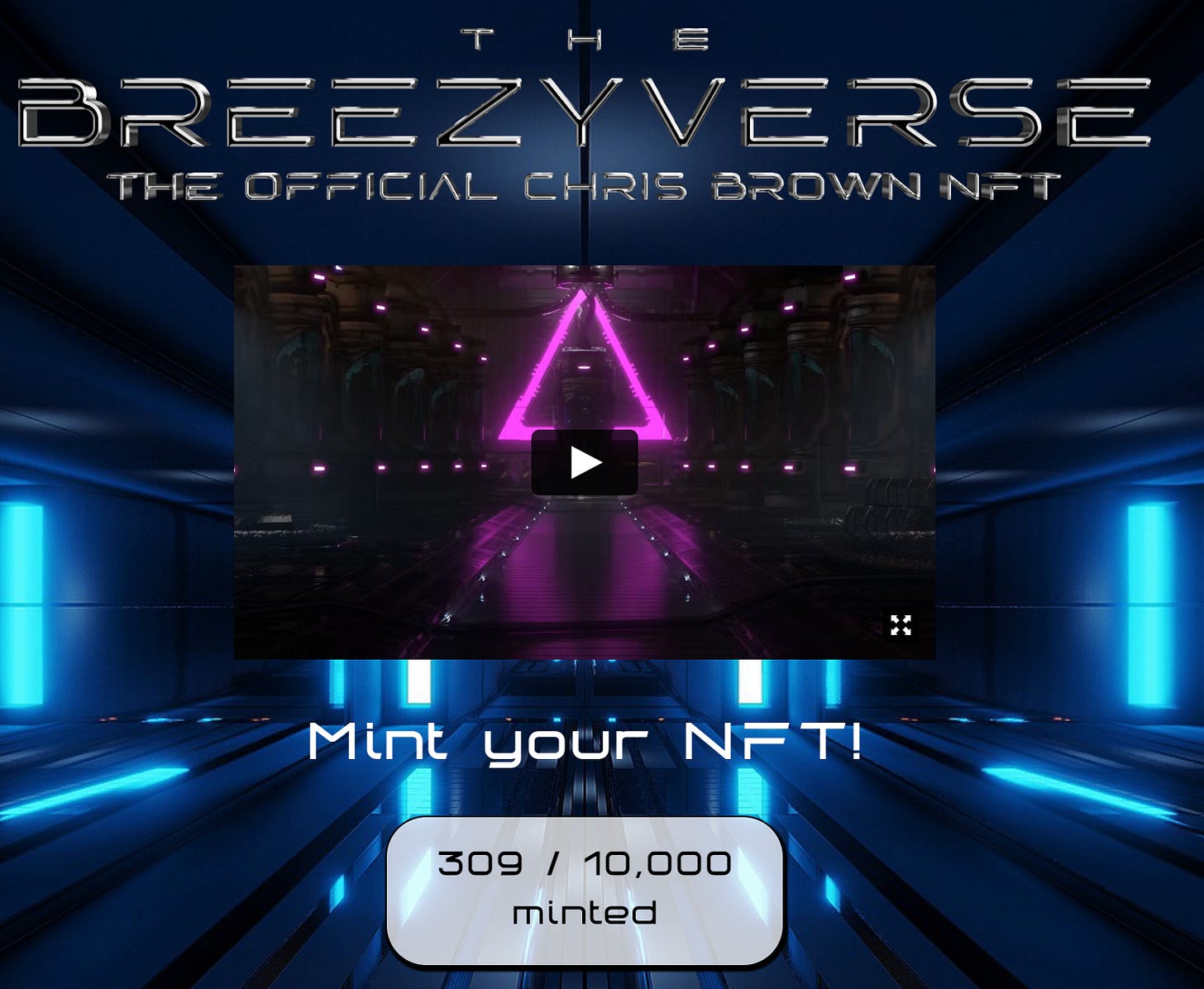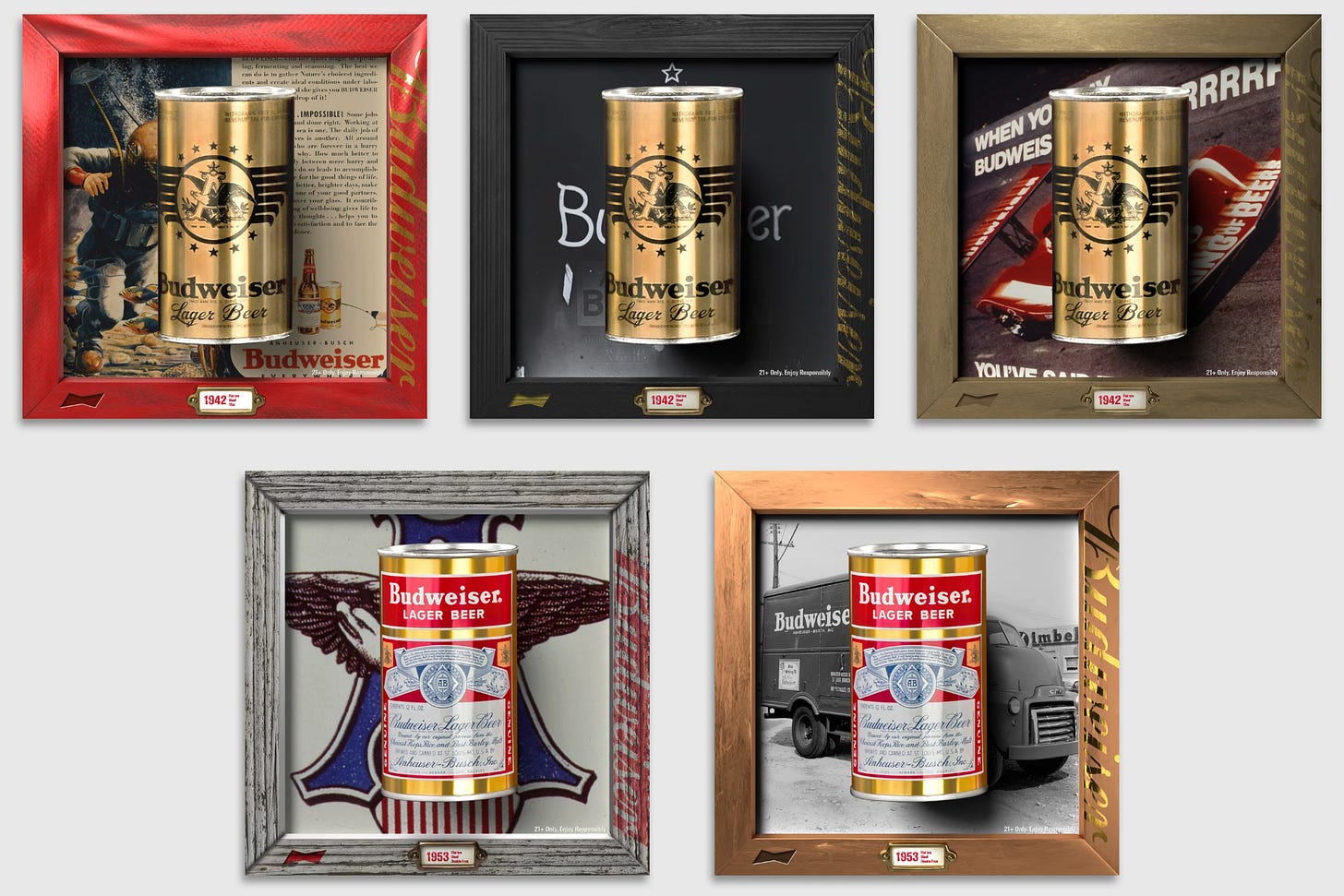A business decision as old as time: “Build vs. Buy?”
I’m sure many of you have had versions of the same question for your own business or the business you work for. Sometimes the answer is obvious, sometimes it’s a 51/49 type of decision.
How does it work in Web3 though, specifically with NFTs?
For building, many Web2 brands that want to get into Web3 are still in ‘wait and see’ mode or are in build mode. But for those that have jumped in have seen their fair share of flops. Remember Kevin Hart and Chris Brown’s projects? No one wants that. Quick update on Chris Brown’s project, let’s see how many have been minted now. We were at 304/10,000 on Friday.
HOLY SMOKES, 309 after the weekend. I feel like everyone that minted Breezyverse should automatically get a private meet and greet with Chris Brown for their dedication.
As for the buy option, this is also complicated with NFTs. Traditional frameworks to evaluate NFT consumer brands don’t apply well. Let’s say you were a venture fund that has the chance to invest in a promising consumer NFT brand. You’re going through some basic info on the opportunities starting with the founders’ names. Here’s one of them:
The other two founder names online are Tulip and BurntToast. A little…better?
What do you do? Pass of course, are you kidding?! This is a scam.
Let’s reveal some more info about poopie.
Co-founder of Doodles, one of the most promising NFT brands in the space.
Wait, can we get a redo? Nope. They don’t need your funding, thank you (they’ve publicly stated that, only raising for strategic partnership purposes).
This is all to say that the Build vs. Buy framework doesn’t apply that well especially if you aren’t a Web3 native team or brand. There are exceptions, and we’ll get into them. But let’s be real, if you’re considering either of those options you’ll need some knowledgeable folks on your side to help (like ya boy TPan 😉).
And that’s where Build vs. Buy vs. Partner comes in.
Partnering
When I was thinking about the ‘Build vs. Buy vs. Partner’ concept, I thought I was smart and that no one else had thought about this before. A quick Google of the term and…
Alright, I don’t deserve credit for this framework lol. But for Web3, maybe a little ;)
Let’s take a step back on the term ‘partnering’ though. When I think of a partnership, I think of something like this:
But if we were to remove the formality of the term ‘partnership’, we see partnerships everywhere. Similar to my piece on Derivatives and Metas, there’s plenty of examples across every industry.
I would argue that all these remixes are a partnership with Ed Sheeran’s original version of Bad Habits.
And that picture of all those Nike ‘derivatives’ in the post?
Those are partnerships too! There’s probably more that I’m missing in the above picture, but I’m not as up to date on sneakers as I used to be, likely for the better haha.
In the streetwear scenes those are called collabs.
Back to the business of fashion, one of my favorite topics. No no, must resist.
Last but not least, let’s talk about one of the most popular forms of advertising today: influencer marketing. Aren’t these a version of advertorial paid partnerships?
McDonald’s has a summer campaign going on this month. Based on the colors and art style, it’s clear that McD’s is catering towards a younger crowd to encourage usage and engagement on the McDonald’s app.
Who are they partnering with? Clothing brands (Free & Easy, Market) skincare brands (innisfree), and music artists (Blackbear, Omar Apollo, Bibi, Kid Cudi). Don’t know any of these names? Don’t worry, you’re not the target market. 😉
Let’s move up the food chain (haha, get it?) to the gold standard of luxury fashion, Louis Vuitton.
But Louis Vuitton is too classy, they don’t partner with influencers! Oh they do, and they make it classy.
Partnering = Collaborating. Dammit, I brought it back to fashion 😂
Anyway, I think it’s important that we understand that from a consumer and brand POV, partnerships is and should be a looser term than we think and is everywhere.
Why partnerships in Web3?
There’s plenty of pros and cons for build, buy, and partner, but let’s focus on why partnering is ideal especially for Web3 (plenty of reasons to build and buy though!), especially if you’re a Web2 brand.
Build
❌ Takes too much time, whether it’s a product or an audience
❌ Requires significant resources and expertise
❌ The space is still maturing, building too early may be unfavorable
Buy
❌ Requires significant resources and expertise (remember poopie?)
❌ Integration may not be smooth. Could negatively impact the acquired brand/team
❌ Timing to buy, especially in Web3 (volatile prices and industry)
Partner
✅ Ability to get expertise while in-house team learns
✅ Reduced risk
✅ Cross-pollination of audiences
So what are some examples of partnerships between Web2 and Web3?









And I can’t forget one of my favorite dives on the Kith Friends (Kith x Invisible Friends) NFT collection.
What about Building and Buying?
There’s plenty going on here, but as mentioned before it takes more time than partnering. @JustGotHereJeff has a great public Google Doc documenting all the big brands that are actively building in Web3. If you still still think Web3 is a fad, you might want to reconsider.
As for buying Web3-native NFT brands, the list is short to my knowledge. However, I believe M&A activity will pick up as:
The bear market continues
The space matures with capital flight towards quality
NFT projects saturate, leading to the stagnation of many once-promising brands in the space. IMO, there will be a lot of valuable IP that will be scooped up for cheap in the coming months and years.
I’m a Web2 brand looking to get into Web3, what should I do?
Consider Partner —> Buy/Build. What does this mean?
Partner
Find executive and employee sponsors: Who’s the executive version of TPan at the company that’s going to sponsor and fight for Web3 initiatives? Who’s the junior version of TPan that knows all the degen plays and spends all their spare time on Twitter and Discord? You need both to reduce the chance of these efforts (for Build and Buy as well) being DOA.
Find the right project(s) to partner with: Want to partner with Bored Ape Yacht Club? Good luck. Want to work with *insert animal pfp project here*? Not worth risking your brand for that. Find a partner NFT brand that complements your Web2 brand, but is established enough. Again, Kith x Invisible Friends is a great example of this.
Be open to different marketing + growth tactics: Marketing in early stage Web3 is different than what is tried and true elsewhere. Whether it’s the channels to promote on, how you communicate, or how budget is utilized, be open to a playbook that is unfamiliar. Work with trusted and established partners (internally and externally) to counter that unfamiliarity.
Buy/Build
Why am I combining Buy/Build? I believe that there are different variations that can be employed here depending on one’s situation:
Buy then Build
Nike acquiring RTFKT. Note that Nike had patents for crypto-related patents since 2018. They’ve been thinking about this for a while.
Hypothetical: Disney acquiring distressed but complementary native NFT brands and their teams, then using their marketing machine to scale it up.
Build
Budweiser - Sure, they’re probably working with agencies and Web3-native partners to support strategy and execution. Definitely building though.
Build then Buy
Yuga (parent company of BAYC) purchased the rights to the Cryptopunks and Meebits collections from Larva Labs a few months ago.
Hypothetical: Disney building out their Web3 team and then acquiring distressed but complementary native NFT brand IP. Acquiring the talent is optional. Then using their marketing machine to scale it up acquired IP and build more.
For those of you that are in active discussions or know of others at the Build/Buy/Partner fork in the road, I hope this helps provide a framework to evaluate the best path forward.
See you tomorrow 😊


















